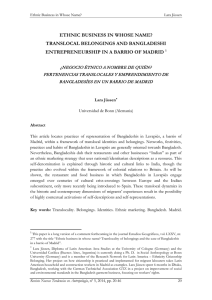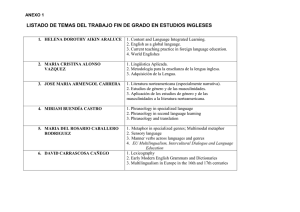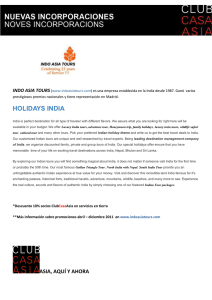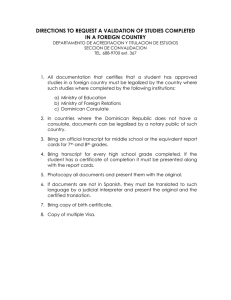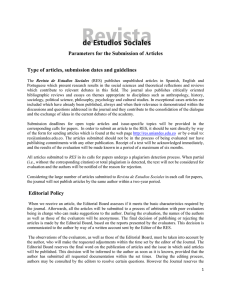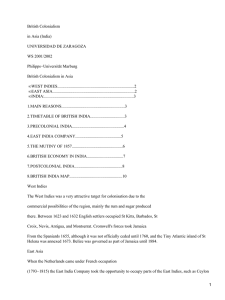Ethnic business in whose name?
Anuncio
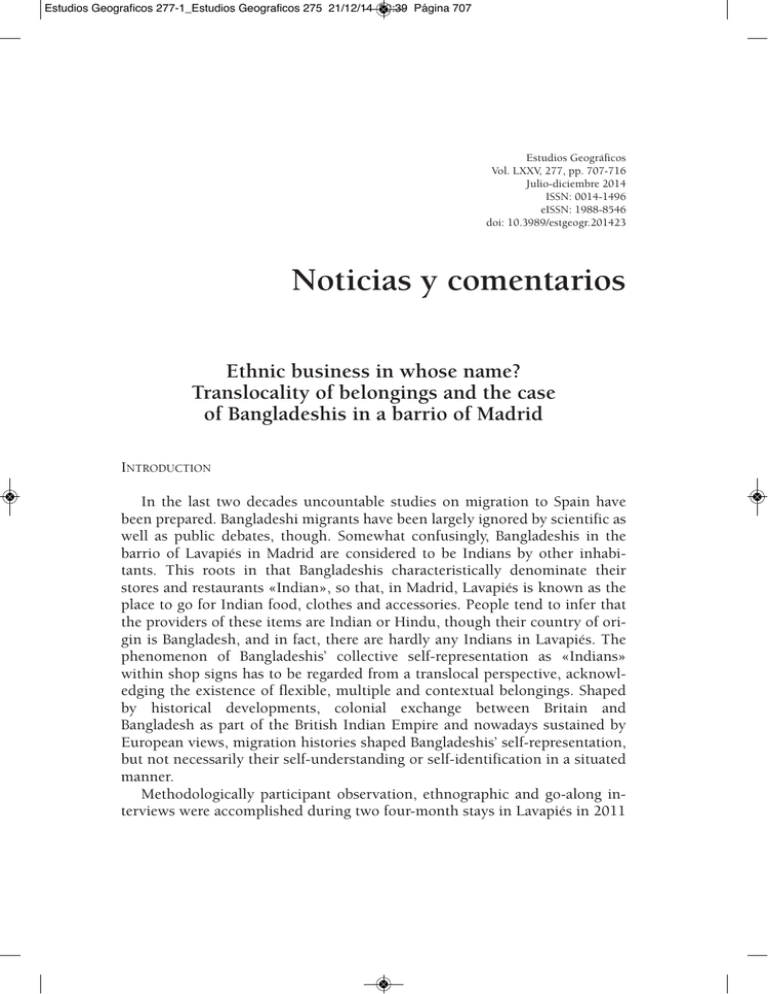
Estudios Geograficos 277-1_Estudios Geograficos 275 21/12/14 20:39 Página 707 Estudios Geográficos Vol. LXXV, 277, pp. 707-716 Julio-diciembre 2014 ISSN: 0014-1496 eISSN: 1988-8546 doi: 10.3989/estgeogr.201423 Noticias y comentarios Ethnic business in whose name? Translocality of belongings and the case of Bangladeshis in a barrio of Madrid INTRODUCTION In the last two decades uncountable studies on migration to Spain have been prepared. Bangladeshi migrants have been largely ignored by scientific as well as public debates, though. Somewhat confusingly, Bangladeshis in the barrio of Lavapiés in Madrid are considered to be Indians by other inhabitants. This roots in that Bangladeshis characteristically denominate their stores and restaurants «Indian», so that, in Madrid, Lavapiés is known as the place to go for Indian food, clothes and accessories. People tend to infer that the providers of these items are Indian or Hindu, though their country of origin is Bangladesh, and in fact, there are hardly any Indians in Lavapiés. The phenomenon of Bangladeshis’ collective self-representation as «Indians» within shop signs has to be regarded from a translocal perspective, acknowledging the existence of flexible, multiple and contextual belongings. Shaped by historical developments, colonial exchange between Britain and Bangladesh as part of the British Indian Empire and nowadays sustained by European views, migration histories shaped Bangladeshis’ self-representation, but not necessarily their self-understanding or self-identification in a situated manner. Methodologically participant observation, ethnographic and go-along interviews were accomplished during two four-month stays in Lavapiés in 2011 Estudios Geograficos 277-1_Estudios Geograficos 275 21/12/14 20:39 Página 708 708 LARA JÜSSEN and 2012. Additionally, some open interviews with experts were held, as with restaurateurs and other businessmen, with representatives of associations and journalists. Moreover, 10 semi-structured narrative interviews centred around guiding questions on personal migration experiences, naming practices of shops and the importance of Bangladeshi festivities were conducted. TRANSLOCALITY, IDENTITY AND BELONGING Translocality is the result of processes of flows and mobility as well as of processes of installation and preservation (of self) within fluid, unregulated situations (Freitag 2005; Freitag & von Oppen 2010). Understood as such, translocality signifies movement of people, goods, ideas and symbols across geographical, cultural or political boundaries and spaces.1 Through these transitions, local adaptations, restructurings and recreations occur, sometimes in a transient, non-permanent manner, producing unordered spaces, departing from the perception of the ‘local’ as a self-contained unit with inherent structures. This article conceptualises identity and belonging through the lens of translocality. Both are conceived as being open, flexible, multiple and contextual and can be associated with shifting, complex and even contradictory locales. But while identity or identification is concerned with created descriptions of self and other, which may be individual or collective, belonging focuses on ties and bonds of connection. Identity is homogenising, while belonging stresses commonality, mutuality and attachments.2 Being more of a ‘docking’ nature, it permits changes in attachments, new ties, links and connections to be established and old ones to become possibly less important. Floya Anthias synthesizes identity as based on narratives of self, myths of origin and destiny, presentation and labelling, while belonging is about «experiences of being part of the social fabric and the ways in which social bonds and ties are manifested in practices, experiences and emotions of inclusion. (…) 1 Freitag, Ulrike & van Oppen, Achim (2010): “Introduction. ‘Translocality’: An Approach to Connection and Transfer in Regional Studies”. Freitag, Ulrike & van Oppen, Achim (ed.): Translocality. The study of globalising processes from a Southern perspective, Leiden, Brill, pp. 1-21. 2 Pfaff-Czarnecka, Joanna (2011): “From ‘identity’ to ‘belonging’ in Social Research: Plurality, Social Boundaries, and the Politics of the Self”, in Sarah Albiez, Nelly Castro, Lara Jüssen, Eva Youkhana (eds): Etnicidad, ciudadanía y pertenencia: prácticas, teoría y dimensiones espaciales. Frankfurt, Main, pp. 197-218. Estudios Geográficos, Vol. LXXV, 277, pp. 707-716, julio-diciembre 2014 ISSN: 0014-1496, eISSN: 1988-8546, doi: 10.3989/estgeogr.201423 Estudios Geograficos 277-1_Estudios Geograficos 275 21/12/14 20:39 Página 709 ETHNIC BUSINESS IN WHOSE NAME? TRANSLOCALITY OF BELONGINGS AND THE CASE... 709 To belong is to share values, networks and practices.»3 Through the concept of ‘translocational positionality’ Anthias describes intersectional inequalities of gender, ethnicity, class, while emphasizing context in complex, shifting and multiple locales. «ETHNIC ECONOMY» IN CROSS- AND SUB-CULTURAL REGARD After a severe decline in family-run businesses in Lavapiés, immigrants have revitalised the area through numerous retail and wholesale shops.4 Bangladeshis are the second most numerous entrepreneurially active group after the Chinese in Lavapiés5, providing considerable co-ethnic workplaces. Nearly all locutorios (phone houses) are run by Bangladeshis, most grocery stores, several Indian clothing and gadget shops, as well as Döner Kebap Houses and Indian restaurants. The concept of «ethnic economy» transmits the idea of ethnic homogeneity disregarding the multiplicity of historic cultural, social, regional, religious, language or political groups and networks within nations. The assessment of an economy as «ethnic» conveys the assumption of a bounded, culturally fixed minority group, but the character of Bangladeshi/Indian businesses observed here differs from progenitors’ culture and they do not primarily supply for the needs of «co-ethnics». Newer studies open the term «ethnic economy» which is «more often a misnomer than accurate»6 to be embedded in crosscultural networks. These might be verifiable for the case in question e.g. through Bangladeshi run Döner Kebap Houses purchasing from Turkish providers, but generally, a different form of cultural crossing is performed: through presenting products and shops as «Indian», Bangladeshi entrepreneurs become the agents of cultural switch. 3 Anthias, Floya (2008): “Thinking through the lens of translocational positionality: an intersectionality frame for understanding identity and belonging”. Translocations: Migration and Social Change 4 (1), p. 8. 4 Riesco Sanz, Alberto (2010): “Inmigración y trabajo por cuenta propia: economías inmigrantes en Lavapiés (Madrid)”, Madrid, Universidad Complutense, Tesis doctoral. 5 Cebrián de Miguel, Juan A. & Bodega Fernández, M. Isabel (2002): “El negocio étnico, nueva fórmula de comercio en el casco antiguo de Madrid. El caso de Lavapiés”. Estudios Geo gráficos 63 (248/249), pp. 559-80. 6 Pieterse, Jan Nederveen (2003): “Social capital and migration: Beyond ethnic economies”. Ethnicities, 3 (1), pp. 29-58. Estudios Geográficos, Vol. LXXV, 277, pp. 707-716, julio-diciembre 2014 ISSN: 0014-1496, eISSN: 1988-8546, doi: 10.3989/estgeogr.201423 Estudios Geograficos 277-1_Estudios Geograficos 275 21/12/14 20:39 Página 710 710 LARA JÜSSEN Investigation in Indian-Bangladeshi borderlands also confers insight into highly relational issues of cross-over ethnic identities and belongings: religious, social and cultural stratification and state affiliation are sometimes maintained and at others collapse.7 Flows of people, goods and culture transgress the border, which was even declared «routinized and thus marginalized or rendered insignificant»8. Families have extensive ties across the border, while inhabitants of the 197 exclave-villages in the territory of the respective other country are forced to break the law daily when going shopping, to school or to the doctor. Within a lifetime, some have changed their «nationality» frequently between British Indian, Pakistani, Indian and Bangladeshi, underlining the considerable relativity of citizenship itself.9 INDIAN OR BANGLADESHI: ETHNIC BUSINESS IN WHOSE NAME? There is no reason or prescription whatsoever of using a certain national or regional indication for business activities. Still, it may seem a bizarre phenomenon that almost all Bangladeshi shop owners refer to India in the names of their business enterprises: in Lavapiés you can find Indian clothes shops, Indian grocery shops and Indian restaurants, all run by people of Bangladeshi origin. Only very few shops, though, use Bangladesh or Bangla as a reference, and then often enumerate other origins, too, such as «Products of Spain, Bangladesh, India, Latin America, Africa», «Fashion from India/Bangladesh» or «Alimentación – African Asiatic Arab Latin – International Products». The great majority of businesses run by Bangladeshi people, though, have «India» written on the store sign instead of «Bangladesh». Interviewees give various explanations for this naming practice, for instance: It is a bit difficult because an Indian restaurant has Indian people... But we were Indians about 50 years ago. And also, the food is very similar. Indian food is very famous all over the world, that is why. The food is nearly the same, only the name is different (Shaimum Khan). 7 Saha, Antu (2007): Ethnic Identities and the Role of Religion on the India-Bangladesh Borderland, New York, EMP. 8 Samaddar, Ranabir (1999): The marginal nation. Transborder migration from Bangladesh to West Bengal, New Delhi, Sage Publication. 9 Van Schendel, Willem (2009): A History of Bangladesh, Cambridge, Cambridbe University Press. Estudios Geográficos, Vol. LXXV, 277, pp. 707-716, julio-diciembre 2014 ISSN: 0014-1496, eISSN: 1988-8546, doi: 10.3989/estgeogr.201423 Estudios Geograficos 277-1_Estudios Geograficos 275 21/12/14 20:39 Página 711 ETHNIC BUSINESS IN WHOSE NAME? TRANSLOCALITY OF BELONGINGS AND THE CASE... 711 People write India only because nobody knows Bangladesh. If they wrote ‘Bangladesh’ nobody would know it and nobody would come, that is why they write ‘India’ (Zahid). The name of India is famous all over the world. It is for business reasons (Tariq). Actually, you know that India, Bangladesh and Pakistan are one country... So actually Indian, Pakistani and Bangladeshi culture is very equal (Sohel). The worldwide fame of India and Indian food was often evoked as reason for referring to India. By employing this kind of «ethnic corporate identity strategy» the business people try to give their mostly European and international consumers an idea of what kind of goods they offer. When referring to India, Bangladeshis are not referring to the country as a political community or nation state, but rather seek to evoke certain cultural associations. In Lavapiés, cultural, national and religious festivities (like international language day Ekushe; Bangladeshi New Year Pohela Boishakh, Bangladeshi Independence day) as well as community organisations, news dissemination, networks of living and working have a decidedly Bangladeshi character. At the same time, though, Bangladeshis are marginalised to the extent of being practically ignored by the general public and important social networks in Lavapiés. Selfpresenting as Bangladeshi seems unattractive under these conditions, while linking oneself to India’s fame helps to overcome this situation. There were only 3 Bangladeshi restaurants in Lavapiés in 2004.10 In 2012, in only one street, there were nine «Indian» restaurants and in the rather small neighbourhood there were an estimated 17 «Indian» restaurants, only one being owned by an Indian, all others by Bangladeshis. Some less highclass restaurants use very simple names, such as «Indian Restaurant» or simply «India». Higher-priced restaurants use names that decidedly refer to India, like the «Restaurante India – Momtaz Mohol», referring to the Taj Mahal; or «Bombay Palace – Indian Restaurant», referring to the former name of the Indian city Mumbai. Jamal, the owner of the «Indian Restaurant» was considering a new name and possibly using «Bangladesh». He held that some restaurants in Britain had changed their names after having referred to India during many years, as regular clients started asking the owners why they used «India» instead of «Bangladesh». But the proven success through referring to 10 Zeitlyn, Benjamin (2007): “Senders Turned into Receivers: Spain, Italy and Bangladeshi Migration”, paper presented at 8th Mediterranean Social and Political Research Meeting. Florence & Montecatini Terme, 21-25 March 2007, organised by the Mediterranean Programme of the Robert Schuman Centre for Advanced Studies at the European University Institute. Estudios Geográficos, Vol. LXXV, 277, pp. 707-716, julio-diciembre 2014 ISSN: 0014-1496, eISSN: 1988-8546, doi: 10.3989/estgeogr.201423 Estudios Geograficos 277-1_Estudios Geograficos 275 21/12/14 20:39 Página 712 712 LARA JÜSSEN «famous India» as a marketing strategy contrasts with the perceived, and probably actual, economic risk of referring exclusively to Bangladesh in the shop’s presentation to the public: The «Baisakhi Indian Restaurant» opened in 1988 on Calle Lavapiés as the first Indian Restaurant in Lavapiés. According to Dr. Shokot Ali, the Baisakhi had originally used «Bangladesh» in its name, and business was going badly until they changed to «India» and business went up, so that now nobody dared to use «Bangladesh» any more. Besides the naming, symbolism is employed strategically: besides pictures of Bangladeshi monuments which European clients are unlikely to recognize, such as the Shaheed Minar, which commemorates the martyrs of the Bengali Language Movement of 1952; or Jatiyo Smriti Soudho, commemorating the martyrs of the War of Liberation, restaurants’ interiors are decorated with pictures of famous Indian monuments like the Taj Mahal, which do not have prominent relevance within Bangladesh itself but are more likely to be recognised by European clients. One principal reason why Bangladeshis make their shops Indian is economic in nature: Everybody always says to us ‘India, India’. And if you say that you are from Bangladesh they say ‘India, India’. Until now they do not know Bangladesh. It is also our fault because we do not represent our country because we always say India. But what counts is the money. In the end, it doesn’t matter if you represent your country or another country because you have to make money (Sahrina). Another frequent reason stated by interviewees for the evocation of India was historic in nature, India, Pakistan and Bangladesh having been one country up until 1947 during British colonial rule. Similarly, high cultural proximity was repeatedly stressed, as through similar food and clothes (salwar kameez or sari for women and lungi or panjabi for men). Using a geographic argument by which «India» referred to the subcontinent of India, some even deducted a «cultural right» to the name of «India». The two states’ political friendship was used to explain that Bangladeshis liked the more libertarian Indian films and Indian dancing, while others remembered the military support by India in the liberation war against Pakistan. Some, however, delimited the «friendship» by denouncing problems Bangladesh has as junior partner with the international power India11. Rejection to using India as an ethnic corpo11 Besides border struggles and killings of irregular migrants by India’s Border Security Force, the relationship is strained due to water issues: In the dry season, India blocks the water supply through the Ganges river and in the rainy season does not care to prevent floods in Bangladesh. Moreover, Bangladesh complains the highly polluted Ganges water. Estudios Geográficos, Vol. LXXV, 277, pp. 707-716, julio-diciembre 2014 ISSN: 0014-1496, eISSN: 1988-8546, doi: 10.3989/estgeogr.201423 Estudios Geograficos 277-1_Estudios Geograficos 275 21/12/14 20:39 Página 713 ETHNIC BUSINESS IN WHOSE NAME? TRANSLOCALITY OF BELONGINGS AND THE CASE... 713 rate identity was expressed by a rather religious shop owner that explicitly used Bangladesh as corporate identity and locational reference. Tellingly, this shop had a distinct business strategy, and could afford to do so, as it sold mainly to a Bangladeshi clientele. Using India’s fame is part of an «ethnic business marketing strategy» that strategically employs ethnicity as resource. Thereby, considerable cultural and historic commonalities and attachments between India and Bangladesh are collectively activated in name-choosing. Name-choosing might therefore be considered as an expression of a form of self-reflective recollection of similarities. Ultimately, there is no need whatsoever to legitimise the use of whatever country or other indication as corporate identity and/or marketing strategy. Another important explanation is to be found in the migration history of Bangladeshis to Europe, hinted at by a few, more informed interviewees who had previously lived in Great Britain. It shows how migrant communities translocally connect and how the experiences of the first Bangladeshi migrant community in Europe influence the practices of today’s Bangladeshis in Lavapiés. MIGRATION HISTORY EXPLANATION AND ANGLO-INDIAN CUISINE By asking: «business in whose name?» and answering with «India», or «Bangladesh», not only is a cultural community evoked, but also a hybrid physical and social place. So, the question could just as well be: «ethnic business with reference to where?» By posing the question in its spatial dimension it becomes more obvious that the answer to this question might also be «Britain», in exchange with where the «curry industry» was elaborated. As Dr. Shokot Ali explains the inclusion of «India» in business names «this comes from Britain. For them we are still India.» The migration history of Bangladeshis to Europe is interlinked with colonial history that interfered with the establishment of Bangladeshis in Britain and characterised their experiences. The delta region of Bengal, now Bangladesh, is where the British East India Company started expanding its power after the battle of Plassey/Palashi in 1757. The territory was transferred to the British Crown in 1858. Seamen from Sylhet, which is today a region of Bangladesh, were employed as workers on British ships since then. Many Bengali families in Britain today trace their ancestry to these sailors. Since the mid-20th century Britain recruited labourers as factory workers from South Asia and the Caribbean. In Bangladesh, Sylhet remained the prime sending area. When immigration laws Estudios Geográficos, Vol. LXXV, 277, pp. 707-716, julio-diciembre 2014 ISSN: 0014-1496, eISSN: 1988-8546, doi: 10.3989/estgeogr.201423 Estudios Geograficos 277-1_Estudios Geograficos 275 21/12/14 20:39 Página 714 714 LARA JÜSSEN were tightened, travelling back and forth became more difficult and settlement became more permanent.12 Through observing the food business, it becomes apparent how practices of former migrants in Britain influence today’s representational practices in Lavapiés. The history of Indian food in Britain dates almost 400 years back, «curry» referring originally to a meat, vegetable or fish dish with spicy sauce of Indian origin, while nowadays it has taken on the meaning of any kind of «Indian dish». The word originated somewhere in or near to India, maybe derived from the Tamil word kari, meaning «spiced sauce». Defenders of the British origins of «curry» hold that the word was used in the title of the first British cookery book, dating from 1390, «The forme of Cury», an adaptation from the French word cuire (to cook, boil, grill), although the word began to be associated with its current meaning only with the arrival of British merchants in the Indian subcontinent at the beginning of the 17th century.13 Curry and India came to be closely connected, and along with Britain’s influence, the «Anglo-Indian cuisine» was created as fruit of historic entanglements. Still, the food eaten by most Indian, Bangladeshi or Pakistani people differs from the food offered in Indian restaurants in Europe, which is adapted for the European taste. Moreover, most Indian cooks, including those in Lavapiés, hold that there is no «Indian cuisine», and that instead the term refers to a certain spicy way of cooking acquired through «learning by doing» and elaborated by the creativity of each cook. Besides, the cuisine within India differs widely from North to South and East to West, its extreme variety reflecting India’s size and cultural and religious diversity. Moreover, foreign dishes were adopted in India, such as Vindalho from the Portuguese, originally a pork dish, today often served with chicken, especially by Muslim restaurateurs, though not by vegetarian Hindus. This high degree of flexibility and variability enabled the further development of the «Indian» cooking style in Britain, along with its commercialisation through high-end spice elaboration into what is now known as the «curry industry», which is accompanied by awards ceremonies like the «Asian Curry Awards» or the «British Curry Awards», visited by high ranking politicians and celebrities. 12 Gardner, Katy (2002): Age, Narrative and Migration. The Life Course and Life History of Bengali Elders in London. Oxford, Berg. 13 Grove, Peter and Grove,Colleen (2008): Curry, Spice & All Things Nice. http://www.menumagazine.co.uk/book/book.html (Fecha de consulta 4/12/2014). Estudios Geográficos, Vol. LXXV, 277, pp. 707-716, julio-diciembre 2014 ISSN: 0014-1496, eISSN: 1988-8546, doi: 10.3989/estgeogr.201423 Estudios Geograficos 277-1_Estudios Geograficos 275 21/12/14 20:39 Página 715 ETHNIC BUSINESS IN WHOSE NAME? TRANSLOCALITY OF BELONGINGS AND THE CASE... 715 There are some Bangladeshi dishes, mostly sweets, which have spread all over the Indian subcontinent. Like Indian cuisine, Bangladeshi cuisine also differs regionally and according to occasion, special festivities being associated with specific dishes. The most widespread meal in Bangladesh is plain rice, bhat (of which tens of different kinds are recognised), eaten with dhal, (lentils, prepared in a more liquid manner than in European Indian restaurants), accompanied with some hot vegetables or a slice of hilsa-fish, hardly available in Europe. The dishes sold in Indian restaurants in Lavapiés do differ from this dish. Moreover, adapting to European taste and habits, dishes are served far less spicy or sweetened, as restaurateurs and cooks in Lavapiés expressed. The food obtainable in Bangladesh was claimed to be the «original» which is copied, including adaptations of Indian-style food. Expectations about Indian food formed within Britain proved to be important: Restaurateurs in Lavapiés held that clients who had visited Britain brought along an idea of Indian food obtained from there, which they tried to satisfy. So, when the restaurateurs refer to the «Indian cooking style», they actually refer to a cuisine that is both influenced by their own Bangladeshi cultural food habits and at the same time imitates Anglo-Indian cooking habits, which have developed over the past centuries between Britain and the Indian subcontinent. This translocational mixture was reflected by a waiter who traced the origin of some of the dishes to England, before correcting himself: they were from Bangladesh, but adapted to European taste. CONCLUSION The Bangla language and ethnic community extends far beyond the borders of Bangladesh into India. Commonalities between Bangladesh and India are evidenced by similarities in food, clothes and cultural practices evolved through centuries of shared history and neighbourly friendship. Self-describing as Indian is not necessarily extrinsic to Bangladeshis and there might even be an imagination of community, though, other than conceptualised by Benedict Anderson, it might be of a kind transgressing narrowly defined «national» grounds.14 This article analysed the initially surprising phenomenon that Bangladeshis in Lavapiés embellish their stores with shop signs displaying 14 Anderson, Benedict (1983): Imagined Communities: Reflections on the Origins and Spread of Nationalism. London, Verso. Estudios Geográficos, Vol. LXXV, 277, pp. 707-716, julio-diciembre 2014 ISSN: 0014-1496, eISSN: 1988-8546, doi: 10.3989/estgeogr.201423 Estudios Geograficos 277-1_Estudios Geograficos 275 21/12/14 20:39 Página 716 716 LARA JÜSSEN reference to India instead of Bangladesh. This public self-(re)presentation of cultural identity is mainly employed for business reasons, though historic, cultural, geographic and friendship factors also matter. Regarding collective naming in its translocally and historically entangled dimension of Bangladeshi migration to Britain, reveals that Bangladeshi entrepreneurs’ references to India are partly attributable to the legacy of colonial times, when Bangladesh was a part of India. Bangladeshi migrants’ introduction in Britain as «Indians» influences the business and marketing methods of Bangladeshis in Lavapiés today, who continue to use proven and successful «ethnic corporate identity strategies». India became an idea that Europeans like to construct around Bangladeshis, exoticising them as Indians, while Bangladeshis within Europe employ their ability for contextual self-representation and use the idea, name and fame of India as a way of connecting themselves to a larger-scale ethnicity, and as a resource. Practices in the naming of businesses are expressions of multiplicity, contextuality and fluidity of business strategies in relation to identitarian practices. By publicly appropriating «Indianness», Bangladeshis in Lavapiés might be practising a cultural representation based on an essentialisation of past and present socio-cultural commonalities. The ties of belongings of Bangladeshis in Spain show to be contextual, shifting and flowing from Bangladesh to Spain and India, being also traceable to migration movements to Britain, with imaginations and representations becoming (re)constructed and formed concretely in-between15, in translocal contexts, (re)producing old and new hybrid16 cultures, identities and belongings. Lara Jüssen University of Bonn 15 Bhabha, Homi (1996): «Culture’s In-between», en Stuart Hall y Paul du Gay (ed.): Questions of Cultural Identity, London, Sage Publications. 16 Néstor García Canclini (1989): Culturas híbridas: Estratégias para entrar y salir de la modernidad, México, Grijalbo. Estudios Geográficos, Vol. LXXV, 277, pp. 707-716, julio-diciembre 2014 ISSN: 0014-1496, eISSN: 1988-8546, doi: 10.3989/estgeogr.201423
